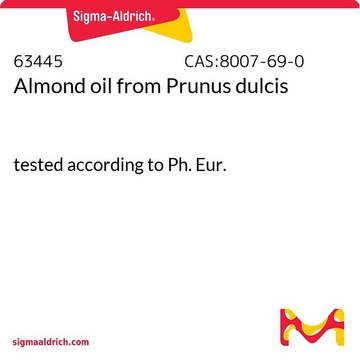243221
Beeswax
bleached
Sinonimo/i:
Cera alba
Autenticatiper visualizzare i prezzi riservati alla tua organizzazione & contrattuali
About This Item
Forma fisica
waxy solid
Colore
white
Punto di fusione
61-65 °C (lit.)
Cerchi prodotti simili? Visita Guida al confronto tra prodotti
Descrizione generale
Beeswax is a natural wax that is formed from honeybee Apis mellifera. It is a lipid that contains hydrocarbons, esters and free acids, which can be used to lower the transference of water on films.
Applicazioni
Beeswax is used to produce edible films (sodium caseinate, soy protein isolate etc.). It can form a mixture with a variety of fatty acids and polyols to provide flexibile, elastic and stretchable films. It also decreases the water vapor permeability and enhances the mechanical properties of the film.
Codice della classe di stoccaggio
11 - Combustible Solids
Classe di pericolosità dell'acqua (WGK)
WGK 3
Punto d’infiammabilità (°F)
509.0 °F
Punto d’infiammabilità (°C)
265 °C
Dispositivi di protezione individuale
Eyeshields, Gloves, type N95 (US)
Certificati d'analisi (COA)
Cerca il Certificati d'analisi (COA) digitando il numero di lotto/batch corrispondente. I numeri di lotto o di batch sono stampati sull'etichetta dei prodotti dopo la parola ‘Lotto’ o ‘Batch’.
Possiedi già questo prodotto?
I documenti relativi ai prodotti acquistati recentemente sono disponibili nell’Archivio dei documenti.
I clienti hanno visto anche
Tensile properties and water vapor permeability of sodium caseinate films containing oleic acid-beeswax mixtures
Fabra MJ, et al.
Journal of Food Engineering, 85(3), 393-400 (2008)
Effect of beeswax modification on the lipid matrix and solid lipid nanoparticle crystallinity
Attama AA and Muller-Goym CC
Colloids and Surfaces. A, Physicochemical and Engineering Aspects, 315(1-3), 189-195 (2008)
Daniel Bauer et al.
Die Naturwissenschaften, 100(1), 45-49 (2012-11-15)
The nests of European honeybees (Apis mellifera) are organised into wax combs that contain many cells with a hexagonal structure. Many previous studies on comb-building behaviour have been made in order to understand how bees produce this geometrical structure; however
R J Stacey
Analytical and bioanalytical chemistry, 401(6), 1749-1759 (2011-06-18)
Residues from medicine containers in the collections of the British Museum have been investigated as part of a wider programme of scientific work on Roman surgical instruments. The cylindrical bronze containers are often described as instrument cases, but some contain
Federico Bernardini et al.
PloS one, 7(9), e44904-e44904 (2012-10-03)
Evidence of prehistoric dentistry has been limited to a few cases, the most ancient dating back to the Neolithic. Here we report a 6500-year-old human mandible from Slovenia whose left canine crown bears the traces of a filling with beeswax.
Il team dei nostri ricercatori vanta grande esperienza in tutte le aree della ricerca quali Life Science, scienza dei materiali, sintesi chimica, cromatografia, discipline analitiche, ecc..
Contatta l'Assistenza Tecnica.